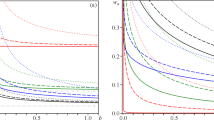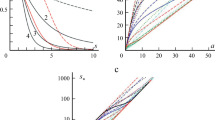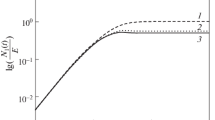Abstract
We formulate a nonlinear Maxwell-type constitutive equation for shear deformation of polymers in flow state or polymer viscoelastic melts and solutions which takes into account interaction of deformation process and structure evolution, namely, influence of the kinetics formation and breakage of chain cross-links, agglomerations of molecules and crystallites on viscosity and shear modulus and deformation influence on the kinetics. The constitutive equation is governed by an increasing material function and six positive parameters. We reduce it to the set of two nonlinear autonomous differential equations for two unknown functions (namely, stress and relative cross-links density) and prove existence and uniqueness of its equilibrium point and that its coordinates depend monotonically on every material parameter and on shear rate. We derive general equations for model flow curve and viscosity curve and prove that the first one increases and the second one decreases while the shear rate grows. Thus, the model describes basic phenomena observed for simple shear flow of shear thinning fluids.
Similar content being viewed by others
REFERENCES
E. C. Bingham, Fluidity and Plasticity (McGraw-Hill, New York, 1922).
M. Reiner, ‘‘Rheology,’’ Encyclopedia of Physics, (Springer, Berlin, 1958), Vol. 6, pp. 434–550.
P. A. Rehbinder, Surface Phenomena in Disperse Systems. Colloid Chemistry. Selected Works (Nauka, Moscow, 1978).
B. D. Coleman, A. Makrovitz, and W. Noll, Viscometric Flows of Non-Newtonian Fluids: Theory and Experiment (Springer, Berlin, 1966).
Ya. I. Frenkel’, Kinetic Theory of Liquids (Nauka, Leningrad, 1975).
G. V. Vinogradov and A. Ya. Malkin, Rheology of Polymers (Khimiya, Moscow, 1977).
E. E. Bibik, Rheology of Disperse Systems (Izd-vo Leningrad. Univ., Leningrad, 1981).
G. M. Bartenev and Yu. V. Zelenev, Physics and Mechanics of Polymers (Vysshaya Shkola, Moscow, 1983).
R. G. Larson, Constitutive Equations for Polymer Melts and Solutions (Butterworth, Boston, 1988).
N. B. Ur’ev, Physicochemical Foundations of the Technology of Disperse Systems and Materials (Khimiya, Moscow, 1988).
A. I. Leonov and A. N. Prokunin, Non-Linear Phenomena in Flows of Viscoelastic Polymer Fluids (Chapman and Hall, London, 1994).
C. Macosko, Rheology: Principles, Measurements and Applications (VCH, New York, 1994).
G. Schramm, A Practical Approach to Rheology and Rheometry (Gebrueder Haake, Karlsruhe, 1994).
C. L. Rohn, Analytical Polymer Rheology (Hanser Publishers, Munich, 1995).
R. G. Larson, Structure and Rheology of Complex Fluids (Oxford Press, New York, 1999).
R. K. Gupta, Polymer and Composite Rheology (Marcel Dekker, New York, 2000).
R. I. Tanner, Engineering Rheology (Oxford Univ. Press, Oxford, 2000).
A. Y. Malkin and A. I. Isayev, Rheology: Conceptions, Methods, Applications, 2nd ed. (ChemTec Publishing, Toronto, 2012).
E. A. Kirsanov and V. N. Matveenko, Non-Newtonian Behavior of Structured Systems (Tekhnosfera, Moscow, 2016).
A. M. Stolin, A. Ya. Malkin, and A. G. Merzhanov, ‘‘Non-isothermal processes and methods of investigation in the chemistry and mechanics of polymers,’’ Russ. Chem. Rev. 48, 798–811 (1979). https://doi.org/10.1070/RC1979v048n08ABEH002412
A. N. Prokunin, ‘‘On the non-linear Maxwell-type defining equations for describing the motions of polymer liquids,’’ J. Appl. Math. Mech. 48, 699–706 (1984). https://doi.org/10.1016/0021-8928(84)90037-6
A. I. Leonov, ‘‘Constitutive equations for viscoelastic liquids: Formulation, analysis and comparison with data,’’ Rheol. Ser. 8, 519–575 (1999). https://doi.org/10.1016/S0169-3107(99)80040-9
J. J. Stickel and R. L. Powell, ‘‘Fluid mechanics and rheology of dense suspensions,’’ Annu. Rev. Fluid Mech. 37, 129–149 (2005). https://doi.org/10.1146/annurev.fluid.36.050802.122132
S. Mueller, E. W. Llewellin, and H. M. Mader, ‘‘The rheology of suspensions of solid particles,’’ Proc. Roy. Soc. A. 466, 1201–1228 (2010). https://doi.org/10.1098/rspa.2009.0445
A. Ya. Malkin and S. A. Patlazhan, ‘‘Wall slip for complex liquids—Phenomenon and its causes,’’ Adv. Colloid Interface Sci. 257, 42–57 (2018). https://doi.org/10.1016/j.cis.2018.05.008
A. M. Stolin, S. I. Khudyaev, and L. M. Buchatskii, ‘‘Theory of viscosity superanomaly of structured systems,’’ Dokl. Akad. Nauk SSSR 243, 430–433 (1978).
A. M. Stolin and V. I. Irzhak, ‘‘Structurally nonuniform flow regimes in the process of polymer fiber formation,’’ Polym. Sci. 35, 990–992 (1993).
N. A. Belyaeva, A. M. Stolin, and L. S. Stelman, ‘‘Modes of firmly-phase extrusion of viscoelastic structured systems,’’ Inzh. Fiz., No. 1, 10–16 (2009).
J. F. Brady and J. F. Morris, ‘‘Microstructure of strongly sheared suspensions and its impact on rheology and diffusion,’’ J. Fluid Mech. 348, 103–139 (1997). https://doi.org/10.1017/S0022112097006320
C. L. Tucker, III and P. Moldenaers, ‘‘Microstructural evolution in polymer blends,’’ Annu. Rev. Fluid Mech. 34, 177–210 (2002). https://doi.org/10.1146/annurev.fluid.34.082301.144051
A. Ya. Malkin and V. G. Kulichikhin, ‘‘Structure and rheology of highly concentrated emulsions: A modern look,’’ Russ. Chem. Rev. 84, 803–825 (2015). https://doi.org/10.1070/RCR4499
K. A. Padmanabhan, R. A. Vasin, and F. U. Enikeev, Superplastic Flow: Phenomenology and Mechanics, Engineering Materials (Springer, Berlin, 2001). https://doi.org/10.1007/978-3-662-04367-7
M. E. Eglit, A. E. Yakubenko, and J. S. Zayko, ‘‘Mathematical modeling of slope flows of non-Newtonian media,’’ Proc. Steklov Inst. Math. 300, 219–229 (2018). https://doi.org/10.1134/S0081543818010194
A. V. Khokhlov, ‘‘Properties of a nonlinear viscoelastoplastic model of Maxwell type with two material functions,’’ Moscow Univ. Mech. Bull. 71, 132–136 (2016). https://doi.org/10.3103/S0027133016060029.
A. V. Khokhlov, ‘‘The nonlinear Maxwell-type model for viscoelastoplastic materials: Simulation of temperature influence on creep, relaxation and strain-stress curves,’’ Vestn. Samar. Gos. Tekh. Univ. Ser. Fiz.-Mat. Nauki 21 (1), 160–179 (2017). https://doi.org/10.14498/vsgtu1524
A. V. Khokhlov, ‘‘A nonlinear Maxwell-type model for rheonomic materials: stability under symmetric cyclic loadings,’’ Moscow Univ. Mech. Bull. 73, 39–42 (2018). https://doi.org/10.3103/S0027133018020036
A. V. Khokhlov, ‘‘Applicability indicators and identification techniques for a nonlinear Maxwell-type elasto-viscoplastic model using multi-step creep curves,’’ Vestn. Mosk. Gos. Tekh. Univ. im. N.E. Baumana. Ser. Estestv. Nauki, No. 6, 92–112 (2018). https://doi.org/10.18698/1812-3368-2018-6-92-112
A. V. Khokhlov, ‘‘Applicability indicators and identification techniques for a nonlinear Maxwell-type elastoviscoplastic model using loading–unloading curves,’’ Mech. Compos. Mater. 55, 195–210 (2019). https://doi.org/10.1007/s11029-019-09809-w
A. V. Khokhlov, ‘‘Possibility to describe the alternating and non-monotonic time dependence of Poisson’s ratio during creep using a nonlinear Maxwell-type viscoelastoplasticity model,’’ Russ. Metall. (Met.) 2019, 956–963 (2019). https://doi.org/10.1134/S0036029519100136
A. V. Khokhlov, ‘‘Two-sided estimates for the relaxation function of the linear theory of heredity via the relaxation curves during the ramp-deformation and the methodology of identification,’’ Mech. Solids 53, 307–328 (2018). https://doi.org/10.3103/S0025654418070105
A. V. Khokhlov, ‘‘Properties of the set of strain diagrams produced by Rabotnov nonlinear equation for rheonomous materials,’’ Mech. Solids 54, 384–399 (2019). https://doi.org/10.3103/S002565441902002X
Funding
The study is supported by the Russian Science Foundation, project no. 22-13-20056.
Author information
Authors and Affiliations
Corresponding authors
Ethics declarations
The authors declare that they have no conflicts of interest.
Additional information
Translated by E. Oborin
About this article
Cite this article
Stolin, A.M., Khokhlov, A.V. Nonlinear Model of Shear Flow of Thixotropic Viscoelastoplastic Continua Taking into Account the Evolution of the Structure and Its Analysis. Moscow Univ. Mech. Bull. 77, 127–135 (2022). https://doi.org/10.3103/S0027133022050065
Received:
Published:
Issue Date:
DOI: https://doi.org/10.3103/S0027133022050065




